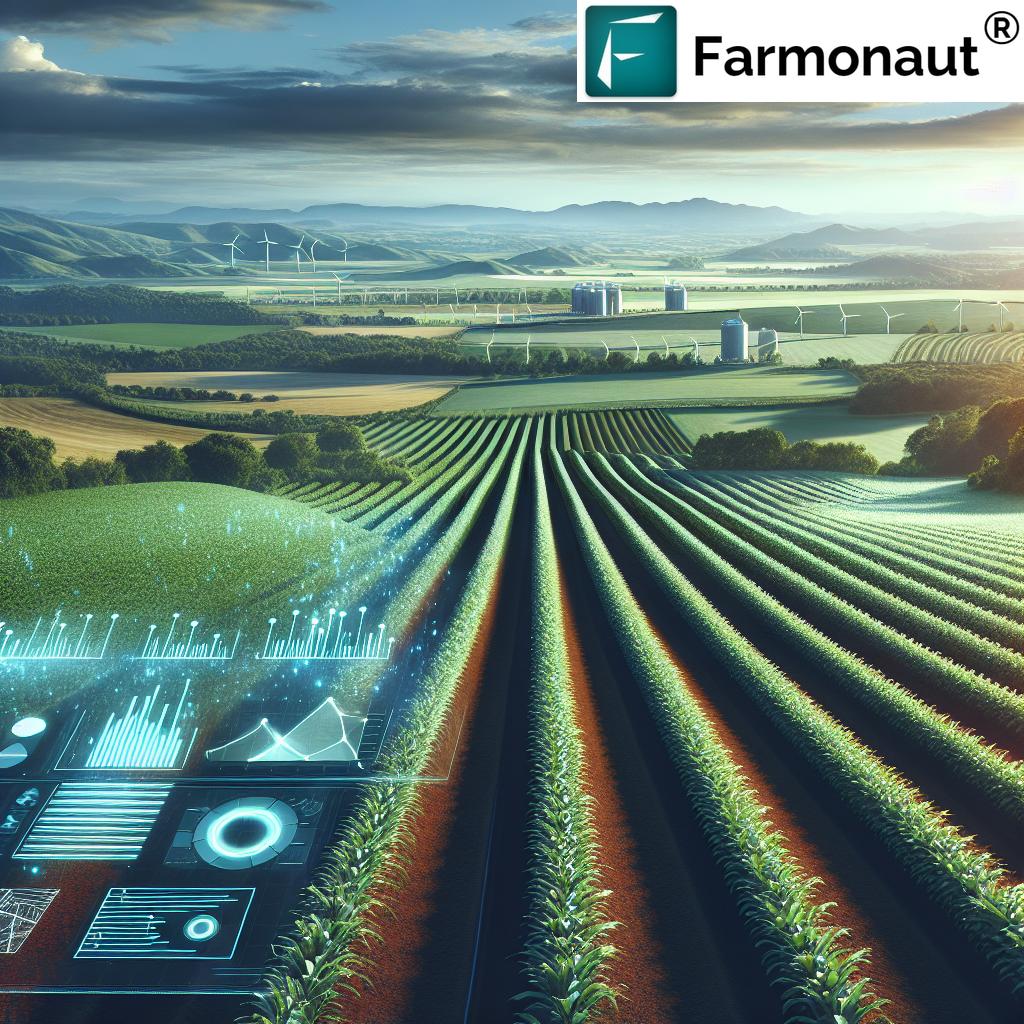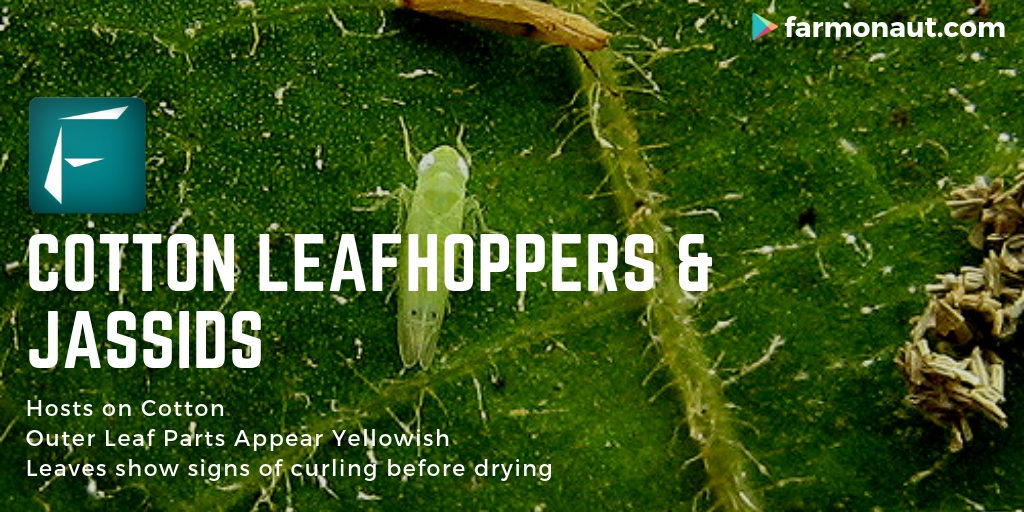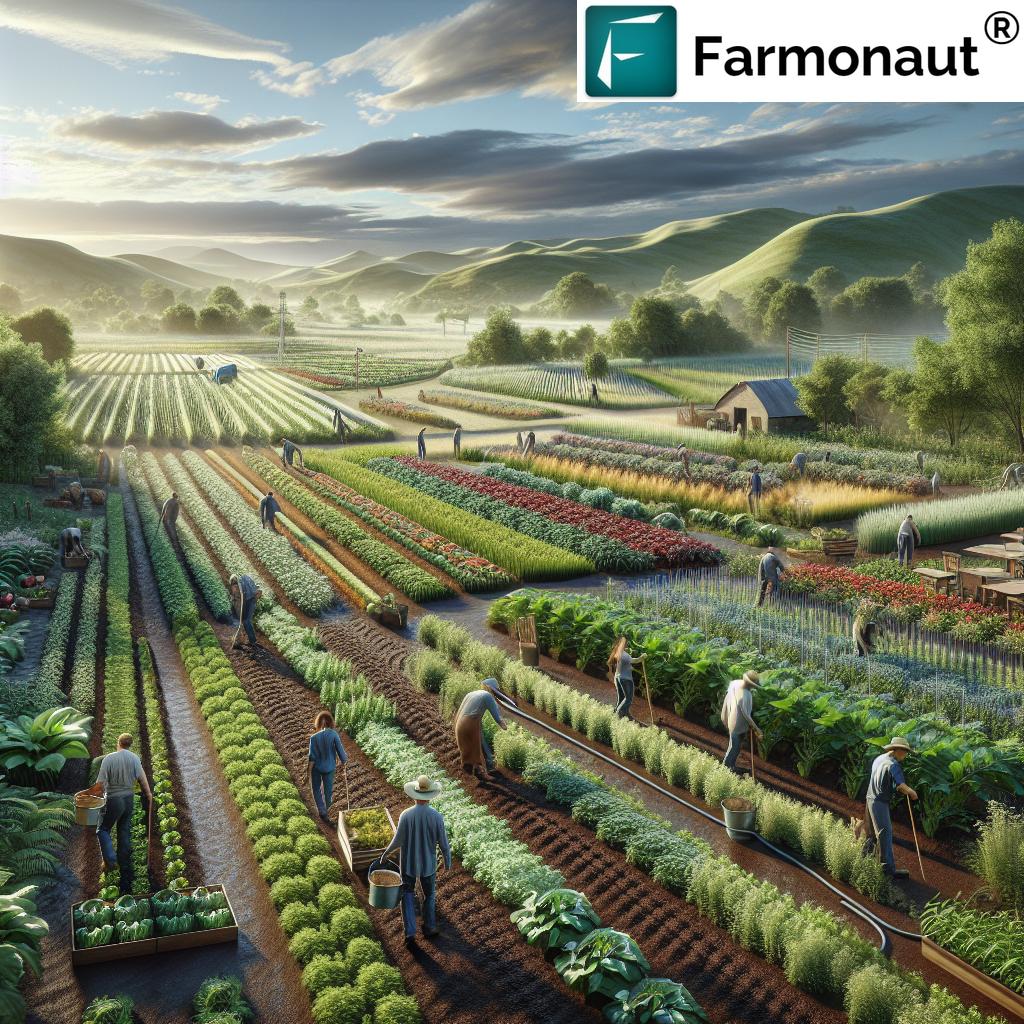Table of Contents
- Introduction: Understanding Modern, Sustainable, and Organic Farming Methods
- Top Trivia
- What Is Sustainable Agriculture? What Is Organic Farming?
- Comparative Matrix: Sustainable Farming vs. Organic Farming (2025)
- Difference Between Sustainable Agriculture and Organic Farming
- Difference Between Organic Farming and Sustainable Farming
- Difference Between Sustainable Agriculture and Modern Agriculture
- Difference Between Natural Farming and Organic Farming
- Which Practices Optimize Health and Sustainability?
- How Farmonaut Solutions Support Sustainable and Organic Agriculture
- Frequently Asked Questions
- Conclusion: Making Informed Choices for the Future of Agriculture
Difference Between Sustainable & Organic Farming: 2025 Guide
In today’s evolving landscape of agriculture, terms like organic, sustainable, natural farming, and modern agriculture are often used interchangeably. However, each term represents distinct philosophies, methods, and goals when it comes to optimizing productivity, environmental and human health, and sustainability. Understanding these vital differences helps farmers, policymakers, and consumers alike make informed decisions that promote a balanced approach to food production, soil and water management, and ecological conservation—key for the future of farming in 2025 and beyond.
This comprehensive guide clarifies the difference between sustainable agriculture and organic farming, dives into the difference between organic farming and sustainable farming, contrasts sustainable agriculture and modern agriculture, and explains the difference between natural farming and organic farming. We’ll also explore which practices truly optimize health and sustainability in the context of 2025. Let’s get started!
“Only 1.5% of global farmland is certified organic, while sustainable methods cover more than 10% worldwide.”
What Is Sustainable Agriculture? What Is Organic Farming?
Defining Sustainable Agriculture
Sustainable agriculture is a broad and holistic approach to farming that aims to meet our current food and fiber needs without compromising the capacity of future generations to do the same. It’s a balance of environmental health, economic profitability, and social equity. This framework employs a combination of traditional knowledge and modern science to achieve the following:
- Reduce pollution and soil degradation
- Optimize resource use such as water and nutrient cycles
- Enhance biodiversity through practices like crop rotation, agroforestry, and integrated pest management
- Promote resilience against climate change by improving farm management systems and risk preparedness
- Preserve healthy soils and ecosystem services
Importantly, sustainable agriculture does not strictly prohibit synthentic inputs like some fertilizers and pesticides. It allows for minimal, carefully managed use, favoring efficiency, reduced dependency, and ecosystem balance over outright bans.
Defining Organic Farming
Organic farming is a subset within the sustainable agriculture framework. It is defined by strict certification standards that eliminate synthetic fertilizers, pesticides, and genetically modified organisms (GMOs). The focus shifts to:
- Natural inputs like compost, green manure, and biological pest control
- Building healthy soils with improved organic matter and nutrient cycling
- Promoting ecological balance and conserving biodiversity
- Strict adherence to regulated guidelines and third-party auditing
Organic farming is thus typically more rigid in input restrictions but narrower in scope—its certification process excludes any system that doesn’t fully comply, even if largely sustainable.
Before examining the nuanced difference between sustainable agriculture and organic farming, explore how these major systems compare side-by-side with our matrix below.
Comparative Matrix: Sustainable Farming vs. Organic Farming (2025)
| Criteria | Sustainable Farming | Organic Farming |
|---|---|---|
| Allowed Inputs (Synthetic Fertilizers & Pesticides) |
Allowed in minimal, optimized amounts (up to 30% use permitted under sustainability protocols) | Strictly prohibited (0% use of artificial chemicals; only natural inputs allowed) |
| Certification Requirements | Voluntary or program-based (varies; may lack third-party certification); negligible annual cost for many | Mandatory third-party certification (Typically 2–3 years transition; average cost: $400–$2,500/year/farm, region-dependent) |
| Environmental Impact (Soil Health Score)* |
7–9/10 (usually positive, can vary with input management and crop choices) | 9–10/10 (maximized soil conservation and organic matter build-up) |
| Biodiversity Impact (Estimated) |
8/10 (encourages crop/livestock diversity, may include integrated habitats) | 9/10 (prioritizes ecological balance and habitats protection) |
| Crop Yield (average yield/acre) |
80–100% of maximum conventional yield | 60–90% of maximum conventional yield (context-specific) |
| Health Outcomes (Pesticide Residue Levels) |
Generally low (<20% of legal limits) | Minimal to none (usually undetectable in certified products) |
“Organic farming bans synthetic pesticides entirely, while sustainable agriculture permits their limited, careful use for ecosystem balance.”
Difference Between Sustainable Agriculture and Organic Farming
Focus on Inputs, Flexibility, and Certification
The primary difference between sustainable agriculture and organic farming lies in input flexibility and certification. Sustainable agriculture encompasses a wider range of agricultural practices designed to maintain long-term productivity and environmental health. It can include modified conventional practices such as reduced chemical fertilizers, precision irrigation, and targeted pest management if those methods help optimize resource use and reduce environmental harm.
By contrast, organic farming is strictly defined by international and regional standards that prohibit synthetic inputs. It mandates a full transition period, detailed record-keeping, and annual audits to qualify for the organic label. This means that while all organic farms can usually be called sustainable (in regards to environment), not all sustainable farms qualify as organic.
- Sustainable agriculture methods may include: minimal synthetic pesticide/fertilizer use, cover cropping, integrated pest management, crop rotation, water-saving irrigation, agroforestry, use of precision technologies.
- Organic farming strictly follows regulated techniques like organic compost, biological pest controls—excluding GMOs, synthetic inputs, and non-organic seeds.
Both systems value ecological balance and biodiversity, but the difference between sustainable agriculture and organic farming is most visible in what methods are allowed and how they are regularly validated.
Difference Between Organic Farming and Sustainable Farming
The difference between organic farming and sustainable farming is subtle, yet significant:
- Sustainable farming encompasses a wider range of agricultural practices. It offers flexibility to combine modern science with traditional methods, allowing judicious use of certain chemical inputs to optimize overall sustainability.
- Organic farming, on the other hand, follows a narrower path with strictly regulated guidelines. It completely avoids synthetic pesticides and fertilizers, focusing on natural means like compost, crop rotation, and biological controls for weed and pest management. Certification ensures organic compliance—but can exclude some innovative, sustainable methods due to regulatory strictness.
Sustainable farming may include methods like precision fertilizer application, integrated pest management, and smart irrigation, as long as these approaches reduce environmental impact and maintain long-term farm viability. It offers more tools for farm managers facing variable climates, volatile markets, or resource constraints—a major asset as we approach 2025 and beyond.
Difference Between Sustainable Agriculture and Modern Agriculture
Understanding the difference between sustainable agriculture and modern agriculture is crucial as the global food system faces increasing climate challenges. Modern agriculture typically refers to large-scale, intensive farming using mechanization, high-yield crop varieties, extensive irrigation, and heavy fertilizer and pesticide use to boost productivity and maximize output. This approach has helped feed billions, but often leads to soil degradation, pollution (mainly water and air), biodiversity loss, and increased greenhouse gas emissions.
By contrast, sustainable agriculture prioritizes ecological and social balance over maximizing short-term yield. Sustainable systems incorporate crop diversity, rotation, organic and minimal chemical inputs, water conservation, and resource-efficient technologies. Instead of focusing solely on yield, sustainable models work to build resilient food systems that will maintain long-term productivity without compromising environmental or human health for future generations.
- Modern agriculture: Prioritizes quantity, efficiency, and scale—but can negatively impact environmental resources if not carefully managed.
- Sustainable agriculture: Seeks to optimize resource use, reduce pollution, preserve biodiversity, and build resilience in the face of climate change.
Incorporating modern tools, like AI and satellite monitoring provided by services such as Farmonaut’s Carbon Footprinting Solution, can bridge the gap—enhancing yields while supporting environmental goals.
Difference Between Natural Farming and Organic Farming
The difference between natural farming and organic farming highlights the spectrum in inputs and philosophies around human intervention and technology. Natural farming, famously shaped by Masanobu Fukuoka, is a zero-intervention or “do nothing” approach that avoids tillage, prepared fertilizers, compost, or any external inputs—whether synthetic or organic. Plants are sown directly with little or no soil disturbance, and the focus is entirely on letting nature and the farm ecosystem self-regulate.
Organic farming shares natural farming’s aversion to synthetic chemicals and GMOs, but it usually involves active soil and crop management with compost, rotation, green manure, and biological pest control. Organic systems are subject to structured certification and auditing, whereas natural farming is more philosophical and not regulated.
- Natural farming: Minimal human input, no soil disturbance, strictly no chemical or even organic amendments; practices seed-saving and spontaneous vegetation.
- Organic farming: Involves proactive management, uses natural fertilizers (compost, organic manure), rotates crops, applies certified biological controls, and undergoes regular audits.
Generally, natural farming appeals to those seeking the utmost simplicity, while organic farming is for those who prefer structured regulation and moderate intervention.
Which Practices Optimize Health and Sustainability?
As we look towards 2025 and beyond, knowing which practices best promote health (for people and the planet) and sustainability is a central question. Key research and field evidence show:
- Organic farming consistently delivers minimal pesticide residues in food, promotes biodiversity, and conserves healthy soils—but yields may be lower, so resource use must be carefully balanced.
- Sustainable (but not necessarily organic) farming—especially when monitoring input use and ecosystem impacts—can achieve near-organic environmental outcomes with higher productivity. In the face of rapid climate change and resource scarcity, this may prove the most adaptive option.
- Smart technology, like AI-driven Fleet Management and Large Scale Farm Management Tools, can help optimize water, soil, and machinery usage—reducing emissions, preventing overuse, and lowering costs.
Ultimately, optimal health and sustainability arise from an integrative approach: drawing upon the best organic, sustainable, and, where necessary, even modern methods. The goal? To tailor practices to regional conditions, farmer goals, and resource constraints, while maintaining resilience and supporting both environmental and human health.
How Farmonaut Solutions Support Sustainable and Organic Agriculture
At Farmonaut, we believe that the future of agriculture is built on satellite-driven insights, AI-based advisory systems, and transparent blockchain solutions. Our technologies help farmers, businesses, and governments optimize their farming operations, improve resource management, and track environmental impact.
Key Features We Offer:
- Satellite-Based Monitoring: Analyze crop health (NDVI), detect soil and water stress, and identify issues before they impact yields. This data-driven approach supports both sustainable and organic farming by enabling precision management and early intervention for pests and diseases with minimal inputs.
- Jeevn AI Advisory: Real-time weather forecasts, pest/disease risks, and tailored agronomic advice streamline decision-making and reduce chemical dependency, aligning with sustainable agriculture priorities.
- Blockchain-Based Traceability: Our blockchain platform ensures transparent, tamper-proof tracking of organic and sustainably-grown products—building consumer trust and supporting compliance with certification and regulatory demands.
- Resource and Environmental Impact Monitoring: Real-time tracking of carbon emissions and nutritional flows helps farms reduce pollution and attain global sustainability standards. Discover our Carbon Footprinting Solution for more on quantifying your farm’s environmental impact.
- Loan & Insurance Support: For organic and sustainable growers, our satellite-based verification helps streamline funding access and reduce fraudulent claims.
Developers can integrate our insights directly into external systems using our Farmonaut Satellite Monitoring API (API Docs).
For advice on plantations and forest, large-scale field management, check out our Agro Admin App.
Frequently Asked Questions (FAQ)
What is the main difference between sustainable agriculture and organic farming?
The main difference between sustainable agriculture and organic farming is flexibility with inputs and certification. Sustainable agriculture can include minimal synthetic inputs if they optimize resource use and reduce environmental risk. Organic farming completely bans synthetic fertilizers, pesticides, or GMOs and is strictly certified based on defined guidelines.
Is all organic farming also sustainable?
Most organic farms use methods that strongly support sustainability. However, the reverse is not always true: Many sustainable farms do not meet every strict certification criterion needed for organic labeling.
Are sustainable farming yields as high as modern or organic systems?
Sustainable farm yields often reach 80–100% of conventional agriculture’s output due to optimized resource use and improved soil health. Organic yields are lower on average, typically 60–90% of conventional, but can be higher in well-managed systems or specific contexts.
What practices can help farms optimize both health and sustainability for the future?
Integrating technologies like satellite monitoring, AI/decision-support, and blockchain traceability with low-impact inputs, biodiversity enhancement, and soil-building practices will enable the highest levels of health and sustainability for 2025 and beyond.
How does Farmonaut support eco-friendly farming?
At Farmonaut, we provide advanced, affordable satellite monitoring, AI-driven advisories, blockchain-based transparency, and real-time resource management to help farms, businesses, and even governments adopt sustainable or organic farming practices with confidence and measurable results.
Conclusion: Making Informed Choices for the Future of Agriculture
As we move towards 2025 and beyond, understanding the difference between sustainable agriculture and organic farming —as well as related distinctions, like the difference between organic farming and sustainable farming and the difference between natural farming and organic farming—will only grow in importance. Each system brings unique strengths, philosophies, and methods to the table. Sustainable agriculture offers a flexible, integrative approach that may draw from modern, organic, or even natural traditions, provided it optimizes health, biodiversity, and long-term productivity while ensuring social and economic well-being. Organic farming, with its certified standards and strictly natural inputs, guarantees maximum transparency for consumers but can be stricter to implement.
Selecting the best path depends on your region, goals, and resource availability—but new technologies and transparent data are making it much easier to blend these approaches for a more resilient, healthy, and sustainable food system.
For anyone striving to support optimal agriculture—from farmers and policy makers to consumers—the goal is now clear: balance input use, preserve soils, safeguard ecosystems, and prioritize the well-being of both people and the planet, for today and for generations to come.












